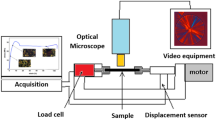Abstract
Morphological observations by optical and scanning electron microscopy, wide (WAXS) and small (SAXS) angle X-ray scattering, differential scanning calorimetry (DSC) and mechanical tests have been performed on sheet specimens of isotactic polypropylene (iPP)/polyisobutylene (PIB) blends obtained under different crystallization conditions. Two kinds of morphologies have been observed, particularly at high crystallization temperatureT c, on thin sections of the same sheets: a spherulitic one in the centre and a row-like structure on the edges. The size of the spherulites, as well as the thickness of the row-like regions, decreases with diminishingT c, and seemsto be independent of the amount of rubber. The adhesion among the spherulites and between the spherulites and the row-like regions seems to become poorer with higherT c. The rubber particles seem to be evenly dispersed into the iPP matrix for samples quenched at low temperatures, whereas for samples isothermally crystallized (at highT c) their concentration seems to be slightly higher at the border of the spherulites than in the centre. The overall crystallinity measured by DSC and by WAXS is an increasing function ofT c and decreases with increasing amount of PIB. Theβ index of iPP phase, quite low indeed (max ≃ 3%), drops with loweringT c and with enhancing PIB percentage. The long spacingL for a given quenching temperatureT q is independent of PIB content, whereas for isothermally crystallized samples at low undercooling varies differently according toT c. The lamellar thicknessL c is always a decreasing function of rubber content. Stress-strain analysis shows a more and more brittle behaviour both with increasingT c (beyondT c=122° C all the specimens are very brittle irrespective of PIB amount) and PIB amount in accordance with the morphological observations. Some tentative hypotheses have been made to explain the observed behaviour.
Similar content being viewed by others
References
L. D'orazio, R. Greco, C. Mancarella, E. Martuscelli andG. Ragosta,Polym. Eng. Sci. 22 (1982) 536.
L. D'orazio, R. Greco, E. Martuscelli andG. Ragosta,ibid. 23 (1983) 489.
E. Martuscelli, C. Silvestre andG. Abate,Polymer 23 (1982) 229.
E. Martuscelli, C. Silvestre andL. Bianchi,ibid. 24 (1983) 1458.
Z. Bartczak, A. Galeski and E. Martuscelli,Polym. Eng. Sci. in press.
A. Galeski, E. Martuscelli andM. Pracella,J. Polym. Sci. Phys. Ed. 22 (1984) 739.
L. Bianchi, A. Buonanno, A. Forte, R. Greco, Ma Rong Tang, E. Martuscelli, F. Riva andC. Silvestre, VI Conférence Européenne des Plastiques, Paris, June 1982, p. IV-20.
P. H. Hermans andA. Weidinger,Makromol. Chem. 50 (1961) 98.
A. Turner-Jones, J. M. Aizelwood andD. R. Beckett,ibid. 75 (1964) 134.
E. Martuscelli, F. Riva, A. Forte andA. Buonanno, to be published.
P. W. Schmidt,Acta Crystallogr. 19 (1965) 938.
A. Peterlin,Polym. Eng. Sci. 17 (1977) 183.
Idem, ibid. 18 (1968) 1062.
Idem, ibid. 19 (1979) 118.
J. D. Ferry, Proc. 5th Int. Congr. Rheol., 1 (1969) 3.
M. I. Kohan “Nylon Plastics” (John Wiley and Sons, New York, 1973) pp. 291–99.
E. S. Clark, in “Polymeric Materials”, (American Chemical Society for Metals, 1975) pp. 1–54.
S. S. Katti andJ. M. Schultz,Polym. Eng. Sci. 22 (1982) 1001.
S. N. Omenyi, A. W. Neumann, W. W. Martin, G. M. Lespinard andR. P. Smith,J. Appl. Phys. 52 (1981) 789.
S. N. Omenyi, A. W. Neumann andO. J. Van Oss,ibid. 52 (1981) 796.
S. N. Omenyi andA. W. Neumann,ibid. 47 (1976) 3956.
R. Hosemann andS. N. Bagchi, “Direct Analysis of Diffraction by Matter” (North Holland, Amsterdam, 1962).
F. Riva andA. Forte, Preprints of the International Rubber Conference 82, Paris, June 1982, pp. 1–25.
E. Martuscelli,Polym. Eng. Sci. in print.
N. Brown andI. M. Ward,J. Mater. Sci. 18 (1983) 1405.
Author information
Authors and Affiliations
Rights and permissions
About this article
Cite this article
Bianchi, L., Cimmino, S., Forte, A. et al. Isotactic polypropylene/polyisobutylene blends: morphology-structure-mechanical properties relationships. J Mater Sci 20, 895–905 (1985). https://doi.org/10.1007/BF00585732
Received:
Accepted:
Issue Date:
DOI: https://doi.org/10.1007/BF00585732




